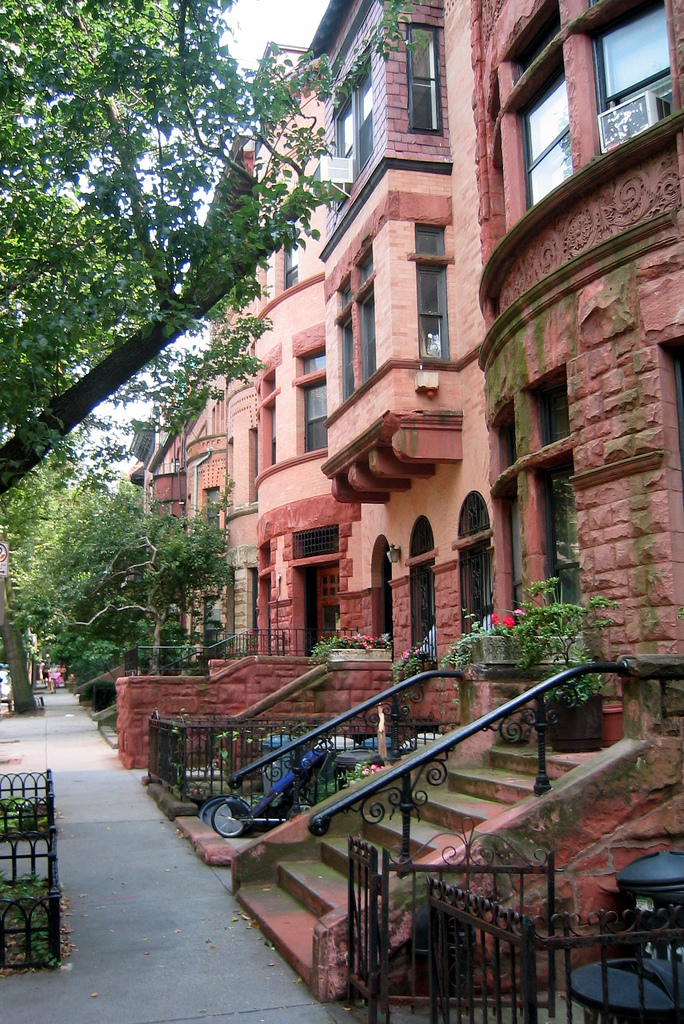
19 Apr TIO NYC: Not Your Mother’s (or the Wait ‘Til Next Year Dodgers’) Brooklyn
“B” is for….
Brownstoners, who helped restore the mansions and brownstones in neighborhoods such as Park Slope to their former picturesque grandeur.
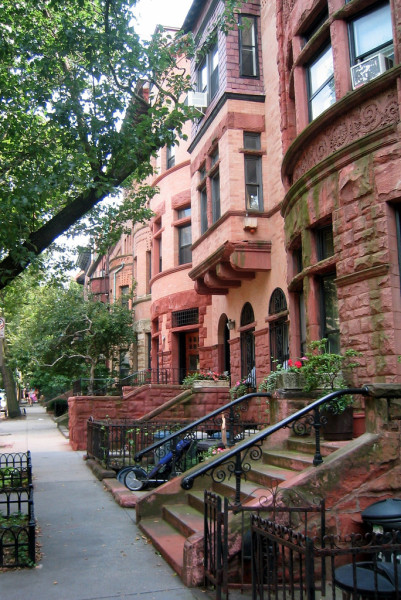
Our new BFFs, Craig and Phoebe, live fully, seamlessly, at the nexus of deep thought, professional accomplishment, savoir faire, social consciousness, and devoted parenting. We met them on a line – note: not online – at the Telluride Film Festival last September. The couple and their adorable, precocious offspring live on Montgomery Place in Park Slope, a strip of townhouses and mansions between Prospect Park West and Eighth Ave, easily one of the most beautiful row-house streets in the borough once known as the Park Slope.
From bowery boys history.com.:
Park Slope – or simply the park slope, as they used to say – is best known for its spectacular Victorian-era mansions and brownstones, one of the most romantic neighborhoods in all of Brooklyn. It’s also a leading example of the gentrifying forces that are currently changing the make-up of the borough of Brooklyn to this day.
During the 18th century this sloping land was subject to one of the most demoralizing battles of the Revolutionary War, embodied today by the Old Stone House, an anchor of this changing neighborhood. In the 1850s, the railroad baron Edwin Clark Litchfield brought the first real estate development to this area in the form of his fabulous villa on the hill. By the 1890s the blocks were stacked with charming houses, mostly for occupancy by wealthy families.
Circumstances during the Great Depression and World War II reconfigured most of these old (and old fashioned) homes into boarding houses and working-class housing. Then a funny thing happens, something of a surprising development in the 1960s: the arrival of the brownstoners, self-proclaimed ‘pioneers’ who refurbished deteriorating homes…
“B” is for Boerum Hill, reputed home to lots of great eats, noted among them, Rucola, where we enjoyed our first dinner in town.
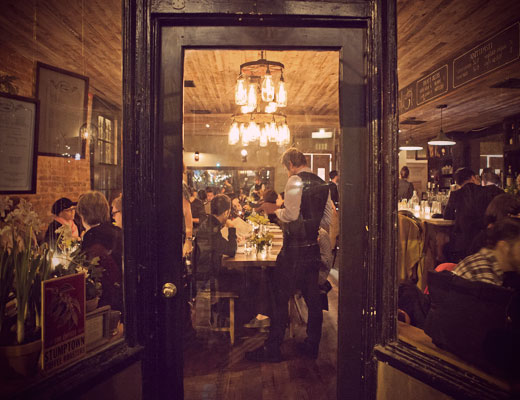
Rucola – means arugula in Italian– is a buzzy, rustic, Northern Italian watering-hole with farmhouse-like warmth (i.e. aged woods and mirrors) and a come-to-the-hood cozy feel.
The farm-to-table restaurant follows in the tradition of Slow Food, a now global movement founded by Carlo Petrini in the mid-1980s with the aim of defending regional traditions, gastronomic pleasures, and a slow (read unMacDonald’s) pace of life. Rucola’s menu, which features the highest quality ingredients available in and right around New York, changes seasonally. The accent is on creative and fresh.
One of Rucola’s founding partners is Julian Brizzi, who has worked in the food industry his entire adult life, polishing his skills as a server, bartender, and manager at top tier eateries like Gramercy Tavern, Frankies Spuntino, and Prime Meats. He also consulted for Gourmet magazine and wrote about food for New York and Food Arts.

Julian Brizzi and Henry Rich, partners in their fifty-seat Boerum Hill restaurant, Rucola.
Brizzi is a close friend of Craig and Phoebe, so despite the fact he was off-site the night we visited, off-piste treats kept materializing at our table to enhance our dinner, including four desserts and a digestif.
Check out praise for Rucola from The New York Times:
Daylight pours through the elaborate window ironwork onto natural woods and restrained bric-a-brac. Famous young actors eat breakfast over scripts. At night, neighbors stop at tables and chat about the children. Everyone fills up on farm-to-table Northern Italian.
Rucola reflects Boerum Hill’s platonic ideal of itself; it’s full of rootsy Brooklyn good taste.
And good tastes. After an uneven start last year, the food is accomplished and satisfying…
“B” is for Barbès, a bar and performance space located in the South Slope. Owned and operated by two French musicians and long-time Brooklyn residents, the tiny bar-restaurant and club space functions as a variation on the theme of neighborhood community center. We learned about the place from another Telluride part-timer named Dennis, a new friend and Brooklyn DA, who lives nearby.
On the menu that night was the Pre-War Ponies, an ensemble which favors forgotten gems of the 20s, 30s and 40s by the likes of Irving Berlin, Cole Porter, the Gershwins, Hoagy Carmichael, and Johnny Mercer.
Featuring Daria Grace – vocals and baritone ukulele; J. Walter Hawkes – trombone, ukulele and vocals; Jim Whitney – bass; and Russ Meissner – drums.
With pipes and chops that won’t quit, the engagingly retro-leaning group should be better known than apparently is, but the Pre-War Ponies do appear on the second Thursday of each month at Barbès.
Here’s a sample of the group in action:
Be there or be square.
“B” is for bespoke jewelry, cheese, granola, beer, baklava – even pickles – at places like The Clay Pot, D’Vine Taste, and Valley Shepherd on 7th Avenue and weekend Farmers’ Markets.
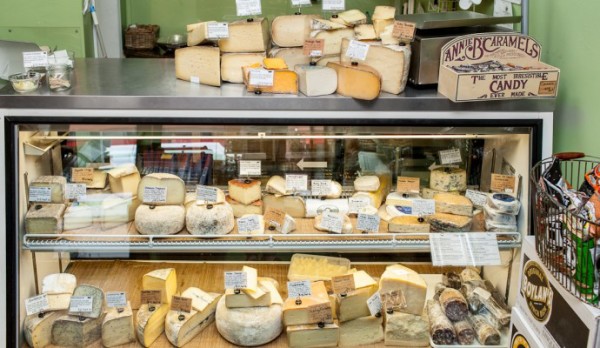
“B” is for the beautiful Botanic Garden, where we strolled on a sunny (yes, finally decent weather in the New York area) Sunday among the burgeoning cherry blossoms with our new Brooklyn friends – and friends of theirs, Sarah Burns and her hubby, Dave McMahon, daughter and son-in-law respectively of the iconic documentary filmmaker Ken Burns, a Telluride regular, who serves on the Board of Governors of the Telluride Film Fest, where Burns’ and McMahon’s “The Central Park Five” had its North American premiere in 2012. (Our story about the doc here.)
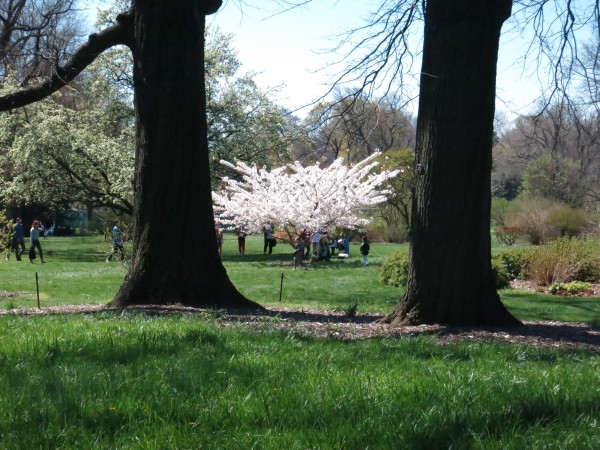
Their latest project (with dear old dad) is a biography of Jackie Robinson, the legendary baseball player who crossed the color line, speaking out loudly against discrimination.
“Jackie Robinson” just aired on PBS. Check out what Ken Burns has to say about his latest project here.
Yes, ‘B” is for Brooklyn, but not the borough of tenements, clotheslines, trolley cars, clamorous factories, street toughs, knishes and lox – and the Wait-’Til-Next-Year Dodgers.
Not the Brooklyn of Betty Smith who wrote “A Tree Grows in Brooklyn,” the coming-of-age classic about a young girl at the turn of the 20th century in the hard-knocks Williamsburg section of the borough, where the author was born.
“Brooklyn is the small town — but on a gigantic scale — that the New Yorker ran away from,” Smith once wrote. “In jeering at Brooklyn’s mores and ideology, your New Yorker may be trying to exorcise his own small-town background.”
And today?
On our visit, we also enjoyed brunch with FOPC (Friends of Phoebe & Craig), a group that included a software programmer, an urban planner, yet another filmmaker, and an artist who makes unicorn ears for kiddos, none of whom spoke with the accent Manhattanites are so fond of mocking.
There was also a dinner prepared at the Montgomery Place town home by another Telluride/Brooklyn local, our friend Lisa, a talented chef– read her dinners are eye-candy, delicious, perfectly planned for the moment at hand and she makes it all look so easy. That evening included Lisa’s husband, a lawyer/entrepreneur; a venture capitalist; an educator with oversight for New York’s early education program; a high-tech advertising exec; and the award-winning architect responsible for the renovation of St.Pat’s Cathedral, one among many stellar achievements – including Craig’s and Phoebe’s stunning digs.
Roll up all of the above into one neat, action- and fun-packed package and it becomes clear Brooklyn’s days as an unsophisticated, unfashionable, generally unhip urban backwater are no more.
They are caput.
Over and done.
Finito.
Amen.
First impressions of Brooklyn?
“Fuhgeddaboudit!”


Sorry, the comment form is closed at this time.